Imagine a world where software development cycles are not only shorter but more secure, scalable, and sustainable. This vision is closer to reality, thanks to the evolution of DevOps. The innovative methodologies in DevOps have revolutionized how IT operations and development interact, breaking down silos and fostering a culture of continuous improvement and collaboration. In this review, we will delve into the core features of DevOps, current trends, and the promise it holds for the future of software engineering.
The Essence of DevOps
DevOps bridges the gap between development and operations, streamlining processes to improve software delivery speed and quality. At its core, DevOps encompasses practices such as continuous integration, delivery, and deployment, all of which prioritize quick feedback and collaboration. This cultural shift encourages teams to work more cohesively within broader technological ecosystems, thus enabling rapid iterations and swift issue resolution. The relevance of DevOps extends beyond its operational efficiencies—it’s reshaping industries by integrating cutting-edge technologies like cloud computing, AI, and machine learning to enhance existing processes. As a result, DevOps has become a cornerstone of modern IT strategy, supporting agile methodologies and underpinning digital transformations across sectors.
Innovations Shaping the DevOps Landscape
Security and Efficiency in DevSecOps
Incorporating security into every stage of software development, DevSecOps transforms traditional workflows by embedding security principles from the get-go. This shift-left strategy enhances both security posture and operational efficiency, significantly reducing vulnerabilities. Automated tools in DevSecOps enable continuous monitoring and threat detection, fostering a proactive security culture.
Cloud-Native Scalability
DevOps leverages cloud-native solutions like Kubernetes and serverless technologies to address scalability and flexibility challenges. Kubernetes orchestrates containerized applications, facilitating seamless scaling across environments, while serverless architectures focus developers solely on code, removing infrastructure concerns. These innovations enhance application resilience while ensuring cost-effective scalability.
AI and Machine Learning Transformations
AI and ML are revolutionizing DevOps, introducing capabilities like predictive analytics and AIOps to streamline operations. Predictive analytics foresees potential system failures, allowing preemptive actions, while AIOps optimizes performance through data analysis. By harnessing machine learning, DevOps adapts dynamically to user demands, ensuring system robustness and improved decision-making.
Trends and Marketplace Dynamics
The DevOps landscape is constantly evolving, influenced by emerging trends and market shifts. Growing emphasis on cost efficiency has propelled practices like FinOps, which optimize resources in cloud environments by fostering cross-functional financial collaboration. Meanwhile, low-code and no-code platforms accelerate application development, empowering teams with minimal coding expertise to innovate swiftly and reduce time to market. DevOps methodologies also emphasize operational transparency through data observability, which provides insights into application performance. Enhanced data visibility aids teams in swiftly troubleshooting issues, preemptively resolving potential disruptions. As such, these trends are pivotal in shaping future DevOps strategies.
Real-World Use Cases
Organizations across diverse sectors reap significant benefits from DevOps implementations. Retailers employ DevOps for enhanced online shopping experiences, while financial institutions leverage it for seamless, secure transactions. Unique use cases, such as healthcare systems deploying DevOps for faster patient data processing, illustrate its expansive applications. This adaptability underscores DevOps’ capability to drive efficiency and innovation industry-wide.
Overcoming Challenges and Barriers
While transformative, DevOps encounters hurdles that require addressing. Technical challenges arise in integrating diverse systems, while regulatory compliance demands vigilance to ensure that innovations comply with sector-specific legal standards. The adoption curve can also be steep, necessitating strategic implementations and ongoing education to overcome resistance and maximize potential.
Efforts are underway to enhance DevOps accessibility, with organizations investing in training and continuous learning to overcome skill gaps. By addressing these challenges head-on, DevOps can realize its full potential as a driver of digital transformation.
Future Directions
DevOps is poised to continue its trajectory of growth, with future developments promising to further integrate cutting-edge technologies. Innovations such as AI-driven automation, enhanced security frameworks, and advanced data analytics are expected to empower DevOps teams. These advancements will open new avenues for innovation, driving efficiency and offering competitive advantages to early adopters.
In closing, while DevOps has already heralded a transformation in software development, its journey is far from over. The evolution of DevOps will likely see continuous integration of novel technologies, widening its impact across industries. As businesses strive to meet ever-growing consumer demands and maintain market relevance, adopting and adapting to these trends will be crucial in ensuring success in an increasingly complex digital landscape.

